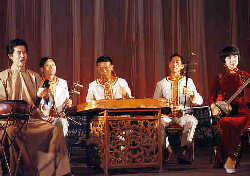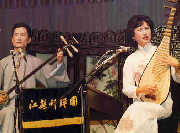 Quyi music is colorful and diverse. More than 80 percent of over 500 quyi genres are in the form of ballad-singing or singing-and-talking. Quyi music is one of the important components of traditional Chinese music and one of representatives of China's oral cultural heritage.
Quyi music is colorful and diverse. More than 80 percent of over 500 quyi genres are in the form of ballad-singing or singing-and-talking. Quyi music is one of the important components of traditional Chinese music and one of representatives of China's oral cultural heritage.
Collection of Chinese Quyi Music, is a publication that combines quyi music, social life and cultural traditions. The Collection integrates sound, music scores, text, graphs and pictures, and is logically and systemically organized and lucidly classified. As a whole, it reflects the evolution, development and current state of quyi music with its accurate and full music scores, general introduction and music text.
Collection of Chinese Quyi Music fully demonstrates China's ancient historical traditions and rich collections of quyi music, It becomes fully evident how splendid and rich quyi music is through 509 genres of opera music identified for Han People alone, such as paizi music, dagu lyrics, tanci, qinshu, daoqing, local ditties, etc. The Collection consists of 29 volumes, one for each province or municipality or autonomous region (except Hainan), with a total of over 43,500,000 words. Each volume has about 1,500,000 words augmented with over 2,000 illustrations of stage performances, representative actors or performers and their relevant historical materials.
Twenty-two volumes of The Collection of China's Quyi Music have already been published and the rest will be completed by 2005.
Paiziqu
Paiziqu is a story-telling and ballad-singing opera using its basic, either using the repetition of one tune name or the joining of a number of tune names. It is popular all over China such as Danxianpaiziqu inBeijing, bajiaogu in Henan qu in Henan, Shaanxi qu in Shaanxi, Lanzhou guzi in Gansu, Qinghai pingxian in Qinghai,Yangzhoudagu in Jiangsu, Jiangxiqingyininjiangxi, Fujian nanyin in Fujian, Sichuan qingyin in Sichuan, Hubei ditty in Hubei, Changyang nanqu in Jiangsu, Hunan sixian in Hunan,Guangxiwenchangin Guangxi, and song-and-dance duet of HeilongjiangJilin, and Liaoning.
Having roots in changzhuan and zhugongdiao of Song Dynasty andYuan Dynastyas well as and folk songs ofMing and Qing Dynasties, Paiziqu has developed into a genre with a multitude of scores and a rich repertoire of tune names. At the time of staging, the number of tune names utilized is determined depending on the story content and length. Every qu music enjoys a unique local flavor and style.
Tanci
 |
|
Suzhou Tanci
|
Tanci has been very popular in southern China since Ming and Qing Dynasties. The singers play a minature sanxian or pipa while singing. There are diverse kinds to Tanci such as Suzhou tanci ofjiangsu,Shanghai and Zhejiang;Yangzhoutanci and Qihai tanci of Jiangsu; Siming nanci and Shaoxingpinghudiao of Zhejiang; Fujian nanci; Guangdong muyuge; and Changshatanci.
Tanci music is composed of basic tunes and tunes of different singing schools. Most of the tunes are melodious, delicate, beautiful, exquisite, clear and smooth; therefore they have strong artistic appeal. There are many fine actors or performers of different tanci schools of different times. The performances are in different forms, of which, the traditional ones are performed by one performer, two performers or three performers.
